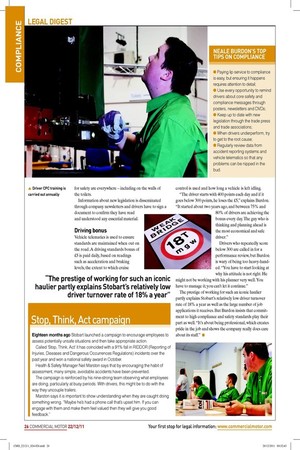Finishing school
Page 19

Page 20

Page 21

If you've noticed an error in this article please click here to report it so we can fix it.
Eddie Stobart demands high standards from its 3,000 drivers, rewarding the most compliant with a £5 daily bonus
Words: Guy Sheppard A lot of prestige is attached to Eddie Stobart’s green, red and black uniform, but some drivers ind the standards that go with it just too demanding.
With a TV special over Christmas, followed by a third series early in the New Year, Eddie Stobart looks set to consolidate its position as one of the country’s 30 best-known business brands.
But celebrity status comes at a price for the Cumbrianbased operator’s 3,000 drivers, who are constantly being reminded that exacting standards are part and parcel of association with its name.
Resource and training manager Neale Burdon says some recruits leave before they have even completed the two-day induction process because expectations are so high. “There are people who think that they can go down the road how they want, but we see this as a very professional job.” That belief is underlined by the company’s new Training Academy in Widnes, which transport minister Mike Penning opened in June. Facilities include a £60,000 truck driving simulator and a demonstration area with a range of tractor units, trailers and reefers.
New recruits receive 14 hours of Driver CPC training, as well as detailed instruction about the standards that are expected of them. “We will show them how to do things and then ask them to do it themselves,” says Burdon. “They won’t leave here until they can do it.”
Overloading injuries
Instruction covers such areas as the correct loading and unloading of cages, which Burdon says is one of the biggest sources of injury to drivers due to overloading.
It also includes buckling curtain straps so they don’t lap in the wind. This might seem petty to a time-constrained driver, but Burdon argues that, as well as appearing neater, it removes a potential distraction when drivers look in their wing mirrors.
Stobart can afford to be picky when selecting drivers. It currently has 1,300 applicants approved for interview – more than double the number that will be recruited over the next year. “My aspiration is to get a proper truck driver, rather than someone who delivers cages to a store,” says Burdon.
This partly explains why the company plans to recruit 150 apprentices annually, with the frst eight due to complete a 13-week course this month. “Apprentices want to be truck
drivers, but a lot of truck drivers are doing it because they ▲ Neale Burdon
have no other option,” says Burdon.
His team of 15 trainers is spread around the country and, although they tend to work in their own patch, they are moved around to ensure consistency of approach. Burdon believes this helps prevent favouritism, which can lead to a loosening of corporate standards.
He looks to reinforce these standards when drivers come to the academy once a year for seven hours of Driver CPC training, so reminders about areas such as coupling and uncoupling of trailers will always be included.
Biggest gripe
“My biggest gripe is a driver in a rush who jumps out of the cab and then immediately pulls the pin for the trailer. A lot of drivers don’t understand that the handbrake does not control the trailer brake.” He adds that the last known incident of a Stobart trailer rolling away due to uncoupling being done incorrectly was nearly 18 months ago.
A DVD covering Stobart’s core safety systems is run regularly in driver mess rooms and posters about the need for safety are everywhere – including on the walls of the toilets.
Information about new legislation is disseminated through company newsletters and drivers have to sign a document to conirm they have read and understood any essential material.
Driving bonus
Vehicle telematics is used to ensure standards are maintained when out on the road. A driving standards bonus of £5 is paid daily, based on readings such as acceleration and braking levels, the extent to which cruise control is used and how long a vehicle is left idling.
“The driver starts with 400 points each day and if it goes below 300 points, he loses the £5,” explains Burdon. “It started about two years ago, and between 75% and 80% of drivers are achieving the bonus every day. The guy who is thinking and planning ahead is the most economical and safe driver.” Drivers who repeatedly score below 300 are called in for a performance review, but Burdon is wary of being too heavy-handed. “You have to start looking at why his attitude is not right. He might not be working with his planner very well. You have to manage it; you can’t let it continue.” The prestige of working for such an iconic haulier partly explains Stobart’s relatively low driver turnover rate of 18% a year as well as the large number of job applications it receives. But Burdon insists that commitment to high compliance and safety standards play their part as well. “It’s about being professional, which creates pride in the job and shows the company really does care about its staff.” ■













































